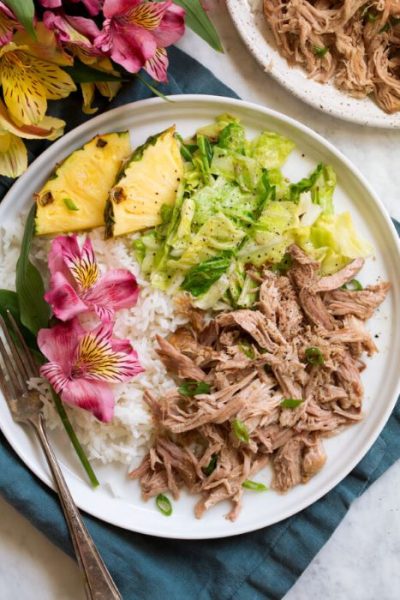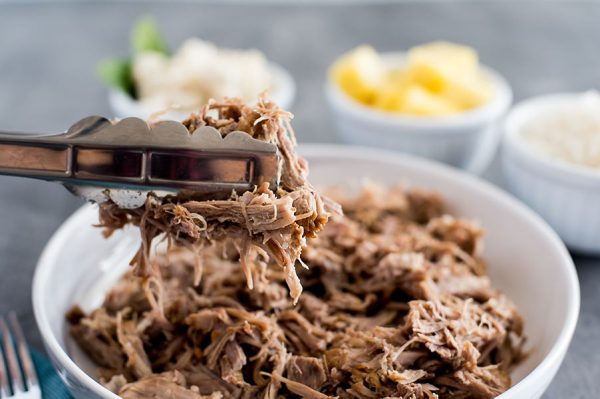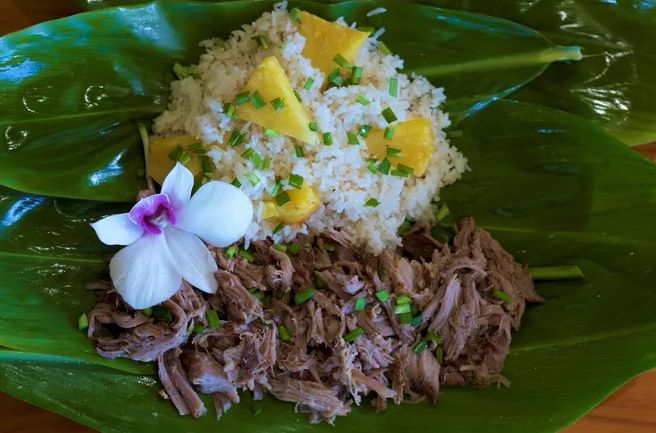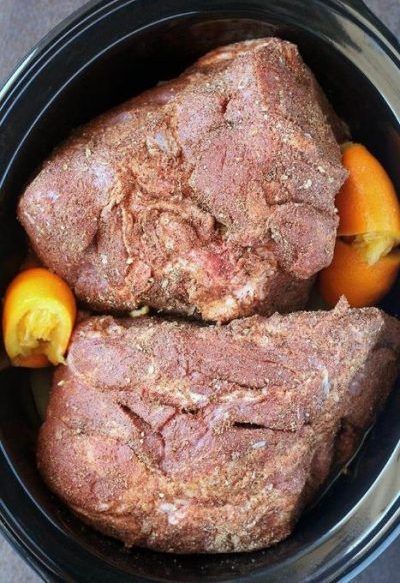Kalua pork, also known as kalua pig, is the quintessential Hawaiian dish. It’s the centerpiece of any luau, a smoky, salty, and tender shredded pork that bursts with flavor.

Traditionally, kalua pork is made by cooking a whole pig in an underground imu, an earth oven lined with volcanic rock. The pig is seasoned with sea salt and wrapped in ti leaves or banana leaves, then slow-cooked for hours over smoldering wood. This imparts a unique smoky taste that’s become synonymous with kalua pork.

While recreating a true imu experience might be out of reach for most home cooks, there are several ways to capture the essence of kalua pork in your own kitchen.
Origins and Cultural Significance
To truly appreciate Kalua pork, it’s essential to understand its roots in Hawaiian culture. Traditionally prepared for special occasions such as luaus (feasts) and celebrations, Kalua pork holds deep symbolic significance in Hawaiian society.
The word “Kalua” refers to the traditional Hawaiian cooking method of slow-roasting in an underground oven known as an imu. This method imparts a distinctive smoky flavor to the pork, creating a culinary experience like no other.

The imu, a pit lined with volcanic rocks, is heated with wood and lava rocks until it reaches scorching temperatures. Once the rocks are sufficiently hot, the pork – typically a whole pig – is wrapped in banana leaves and placed in the imu. The heat from the rocks and the steam created by the banana leaves work together to cook the pork slowly and evenly, resulting in tender, flavorful meat infused with the essence of the earth.

While the traditional imu method remains central to the cultural significance of Kalua pork, modern adaptations have made this beloved dish accessible to home cooks and restaurants around the world. Whether prepared in an imu, a conventional oven, or even a slow cooker, the essence of Kalua pork – its rich flavor and tender texture – remains unchanged.
Slow Cooker Kalua Pork
This is the easiest and most popular method. A bone-in pork shoulder (also called pork butt or Boston butt) is seasoned with Hawaiian or sea salt, liquid smoke, and sometimes additional flavors like garlic or paprika.

The pork is then slow-cooked in a crockpot for many hours, resulting in fall-apart tender meat that shreds easily.
Preparation and Ingredients
The beauty of Kalua pork lies in its simplicity. While the traditional imu method may be impractical for everyday cooking, the ingredients and techniques required to replicate the flavor of authentic Kalua pork are surprisingly straightforward.

The key ingredient in this pork is, of course, the pork itself. Traditionally, a whole pig is used for special occasions, but for everyday cooking, pork shoulder or pork butt are commonly used due to their flavorful and tender meat. To achieve that signature smoky flavor, a small amount of liquid smoke is often added to the pork before cooking. Salt, usually in the form of Hawaiian sea salt, is generously rubbed onto the meat to enhance its flavor and aid in the tenderization process.
While the traditional imu method involves slow-roasting the pork in an underground oven, home cooks can achieve similar results using more accessible cooking methods. One popular technique is to slow-cook the pork in a conventional oven or slow cooker, allowing it to cook low and slow until it reaches fall-apart tenderness. Some recipes also call for the addition of aromatic ingredients such as garlic, onions, and bay leaves to enhance the flavor of the pork.

The finished this pork is typically shredded or pulled apart, resulting in tender, juicy meat with a deliciously smoky flavor. It can be served on its own as a main dish or incorporated into a variety of dishes, from tacos and sandwiches to salads and rice bowls.
Kalua pork is more than just a dish; it’s a taste of Hawaiian culture and tradition. So fire up your slow cooker, Dutch oven, or Instant Pot, and bring the flavors of the luau to your own kitchen!
Savoring the Flavor
What sets Kalua pork apart from other barbecue-style meats is its unique combination of flavors and textures. The slow-cooking process allows the pork to absorb the smoky essence of the cooking method, resulting in a depth of flavor that is both complex and comforting.
With each bite of Kalua pork, you’ll experience a symphony of flavors – the rich, savory taste of the pork, the subtle sweetness of the banana leaves, and the lingering smokiness that dances on your palate. The meat is tender and succulent, practically melting in your mouth with every forkful.
Pairing Suggestions
While this pork is delicious on its own, it can also be paired with a variety of side dishes and accompaniments to create a memorable meal. Here are a few pairing suggestions to complement the flavors of Kalua pork:
- Steamed white rice: The simplicity of steamed white rice provides the perfect canvas for showcasing the bold flavors of Kalua pork.
- Macaroni salad: A classic Hawaiian side dish, macaroni salad adds a creamy, tangy contrast to the smoky richness of Kalua pork.
- Pineapple salsa: Fresh pineapple salsa adds a burst of tropical flavor to each bite of pork, making it feel like a mini vacation with every mouthful.
- Grilled vegetables: Lightly charred grilled vegetables such as bell peppers, zucchini, and eggplant provide a refreshing contrast to the richness of Kalua pork.
Conclusion
In conclusion, Kalua pork is more than just a dish – it’s a celebration of Hawaiian culture, tradition, and the joy of sharing a delicious meal with loved ones.
Whether prepared using the traditional imu method or adapted for modern kitchens, the irresistible flavor of Kalua pork never fails to captivate the senses and transport diners to the sun-drenched shores of Hawaii.
So why not bring a taste of paradise to your next meal with a heaping serving of Kalua pork? Your taste buds will thank you for it!



